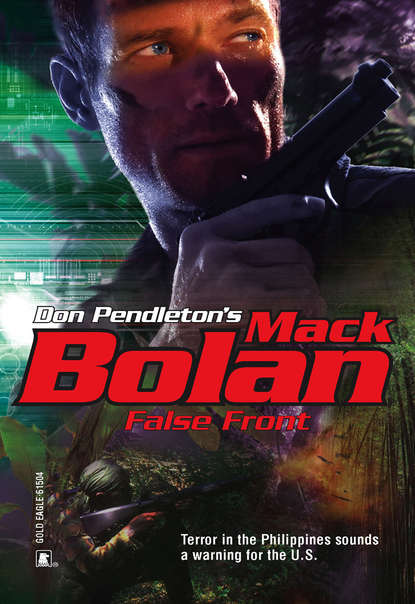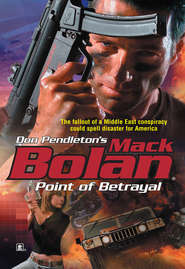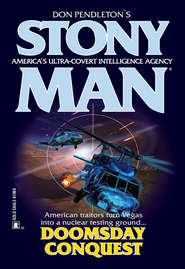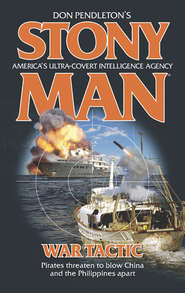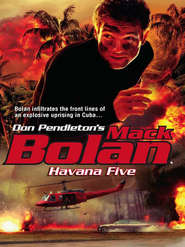По всем вопросам обращайтесь на: info@litportal.ru
(©) 2003-2024.
✖
False Front
Автор
Год написания книги
2019
Настройки чтения
Размер шрифта
Высота строк
Поля
Latham nodded, then reached across the Executioner and opened the glove compartment. “Thanks for reminding me.” He pulled out a cocked-and-locked Browning Hi-Power with a stainless-steel frame, blued slide and what looked like black plastic and rubber grips. As he lifted the weapon and brought it across to his belt, Bolan noticed a small ramp at the top of the grip just behind the trigger guard. And as the gun moved through the air, a tiny red dot raced across the dashboard in front of the barrel.
“That 9 mm or .40?” Bolan asked as Latham jammed the weapon into his shorts.
“It’s a .40 S&W,” Latham replied, grinning. “Remember the Moros.”
Latham reached into the glove compartment again and pulled out a black nylon double magazine carrier, which he stuffed into one of his pockets. Bolan settled back in his seat as his contact pulled the Cherokee onto the road. He didn’t need to ask about the red dot he’d seen dancing in front of the Browning. A laser site. And the ramp in the grip and lack of any exterior wiring on the pistol, meant the laser was one of Crimson Trace’s new models for the Hi-Power. The laser beam shot out the front of the ramp when a button—activated by taking a normal grip on the weapon—was depressed. Wherever the red dot fell, the bullet followed as soon as the trigger was pulled.
Latham drove back to the spot where they had originally planned to meet. But there was still no sign of the CIA man. He turned to Bolan, but before he could speak the big man said, “Let’s go on. We’ll either hook up with him later or we won’t.”
The Texan nodded. “Undercover work never was my specialty,” he said. “But I’ve done some. And if there’s one thing I learned, it’s that you can get delayed. You’re always working on someone else’s timetable.”
“Maybe he’ll have some decent intel when he shows up,” Bolan said.
The two men fell into silence again as the Cherokee bounced over the bumps and cavities in the asphalt. Ahead, the outskirts of Zamboanga appeared and clusters of stilt houses—running from the shoreline well out over the sea above the water—began to sprout.
Latham was the first to speak again. “Hawk told me you weren’t the most talkative guy around,” he said as he twisted the wheel and turned the vehicle onto San Jose Road.
“I talk when I’ve got something to say,” Bolan told him.
“That’s not what I meant,” Latham said as rural Mindanao continued to become more suburban. “What I meant was, Hawk advised me not to ask you a lot of questions about yourself.” He glanced at the Executioner then turned his eyes back to the road. “Like, what your real name is or where you’re from or who you work for.”
Bolan turned sideways in his seat. For a long moment he didn’t answer. The connection between him and Latham had come through T. J. Hawkins of Phoenix Force—one of the counterterrorist teams working out of Stony Man Farm. Hawkins and Latham had been friends as kids growing up in Texas and by chance had become reacquainted when both had been assigned to Delta Force. Hawkins eventually resigned and later joined Phoenix Force. Latham had retired, too, becoming an American ex-patriot on Mindanao to study the martial arts.
Finally the Executioner said, “Did T.J. tell you who he worked for when he called?”
“Nope,” said the man behind the wheel. “Sure didn’t.”
“But you asked?”
“Sure did.”
“Well, I can’t tell you, either,” the Executioner said as he turned back toward the windshield. “Thanks for picking me up. I appreciate it. And while T.J. tells me you were as good as him when you were both with Delta Force—and I could use some backup while I’m here—I’ll understand if you want to bail out. No hard feelings.” He paused a second, then added, “I’m not sure I’d trust someone I just met on a deal like this.”
A look of genuine surprise shot across Latham’s face as they passed a large athletic field set well off the road. “Hawk’s word about you is good enough for me,” he said. “I’m in for the duration—or until you kick me out. To tell the truth, things get a little boring around here after a while. I mean, how long can you bang rattan sticks against each other and stab your training partner with rubber training knives before you’d kind of like to get out and do something else for a while? “He paused, took in a deep breath and let it out again. “Don’t get me wrong. I love what I’m doing. Kali, Arnis, Escrima—the Philippines have the most practical martial arts in the world, you ask me, and the best of the best is right here on Mindanao. But other than that, once you’ve been to Fort Pilar and seen the Yakan Weaving Village, there’s not a whole lot left to do.”
When Bolan didn’t respond, Latham went on.
“Okay, look,” the Texan said, lifting his hat off his head and wiping a hand across his scalp. “Hawk was the best friend I had when I was a kid. I could tell you stories about trouble we got into that would curl your ears.” He stopped, glanced at the Executioner, then amended the statement. “Well, maybe not your ears but most people’s. And Hawk was the best trooper to ever come out of Delta Force, too—don’t listen to him when he tells you I was just as good. I wasn’t. Anyway, one thing you could always count on out of Hawk was getting the truth. Bottom line—if he says you’re okay and I should work with you and not ask questions, that’s good enough for me.”
The Cherokee passed Don Basillio Navarro Street, then turned south on Alvarez. A few minutes later it turned east and entered the city proper. Barely slowing the vehicle, Latham guided them in and out of residential and business areas, past houses, restaurants and bars. The streets were alive with activity. Children played happily in front of houses and older, more sullen youths, gathered on street corners to glower as they passed.
Bolan was reminded that Mindanao’s cities, as well as its hinterland, were hotbeds of crime. Robberies, rapes and murders of both tourists and natives were common, and kidnapping for ransom—especially of Americans—was almost the national sport.
Pablo Lorenzo Street took them to Valderoza and they drove past Fort Pilar, which Latham had mentioned earlier. Bolan recalled that the fort had been founded by the Spaniards in the early seventeenth century, and conquered at various times by the Dutch, Moros, British and even the Japanese during World War II. Finally claimed by the Filipinos themselves, the fort now housed a marine museum and an ethnographic gallery that concentrated on the Badjao—or sea gypsies—who spent most of their lives on houseboats along the Sulu Archipelago.
Just past the fort they turned away from the city. According to the CIA, Subing’s home was in Rio Hondo, a small village—almost a suburb—to the east.
The Jeep topped a rise in the road and in the distance they could see the spiral towers of a village mosque. The Texan snorted humorously and shook his head. “Rio Hondo,” he said. “Sounds like a John Wayne movie, doesn’t it?”
Bolan smiled as they drove toward the village. He had taken a liking to Charlie Latham and appreciated the man’s unique way of viewing life. Latham was a straightforward type and, according to Hawkins, one heck of a fighter both with, and without, weapons. The Executioner hadn’t seen any firsthand proof of it yet but he suspected he’d find out up close and personal before this mission ended. Until then Hawkins’s word—which had given Latham confidence in Bolan—also meant the Executioner could trust the Texan when the going got tough.
The road rose and fell as they neared Rio Hondo and with each rise Bolan caught glimpses of the shoreline and water beyond. Several shallow-draft sailboats—vintas—moved gently back and forth along the coast. In them he could see tiny brown figures casting fishing nets over the sides. He was so occupied when he suddenly heard Latham say, “Uh-oh,” in a calm voice.
The Executioner turned his attention back to the road. They had just rounded a curve and Latham was slamming on the brakes, barely coming to a halt before hitting an ancient, rusting Chevrolet parked in the lane in front of them. Blocking the oncoming lane—and preventing them from passing—stood an equally old Ford Fairlane with a huge dent in the front fender. Two men stood between the vehicles, their arms waving wildly as they shouted at each other. To the average tourist it would have appeared that they had just been involved in an accident and were attempting to assign the blame.
But Bolan was neither tourist nor average. And neither was Latham.
“Kidnappers,” Latham said quickly as he pulled the Browning from his waistband. “Fake car accident. Standard ploy.”
Bolan didn’t need to be told. The Desert Eagle had come out of its holster the moment he’d seen the two cars. Now, as the two arguing men turned to face the Cherokee, he held the big .44 Magnum pistol just out of sight below the dashboard.
Both men wore dingy brown shirts, the tails untucked over baggy, tropical fabric slacks. They smiled as they began to casually walk forward as if to ask for assistance.
Then the shirttails came up and both men pulled pistols from their belts.
The Executioner twisted the door handle, threw open the door and leaped from the Cherokee. As he did, he saw a half dozen more men with AK-47s suddenly rush out of the jungle at the side of the road. The outbreak of automatic rifle fire behind him told Bolan that even more gunmen had appeared from the jungle on the other side of the road. As he dived below a burst of 7.62 mm rounds he wondered briefly if Latham had gotten out of the car. He hadn’t heard the man’s door open amid the explosions.
Bolan returned his attention to the men on his side of the vehicle. Latham was either alive or he was dead. Either way, there was nothing the Executioner could do to help him at the moment.
Another volley of fire struck the Cherokee as Bolan hit the ground and curled his body into a shoulder roll. As he rolled he caught a flash sight of the six men in front of him, his brain registering the fact that they wore a mixture of camouflage and more traditional dress. He wondered briefly if kidnapping was really their objective. The ambush was taking on more of the aura of a well-thought-out terrorist op.
Maybe even an assassination. Did the Tigers know he was on the island?
The Executioner pushed the possibility to the back burner for the moment. Right now it made little difference who the men were or what they wanted. They meant to kill both him and Latham, and at this point the important thing was to make sure they didn’t get it done.
Bullets struck the highway’s shoulder to both of the Executioner’s sides. Huge chunks of black asphalt, heated to softness by the hot Mindanao sun, ripped open as if tiny earthquakes had erupted. Bolan’s brain raced at near-inhuman speed, analyzing, evaluating, taking in the details of the situation. He weighed the odds and calculated the percentages of every possible course of action as he rolled beneath the onslaught.
The bottom line was grim. He was outnumbered and outgunned. There were six men directly in front of him, and even if he could make it to the rear of the Cherokee some of them would still be angled for clear shots. But the rear of the vehicle was the nearest thing to cover available so it was toward that goal he would have to fight.
Bolan rolled again amid a shower of lead. The gunmen on Latham’s side of the vehicle continued their assault, their rounds exploding from that direction.
The Executioner rolled up to one knee and lifted the Desert Eagle. The enemy had both superior manpower and firepower. He and Latham had superior thinking, superior thinking that could be turned into superior strategy. And both the thinking and the strategy would have to be far superior.
The Executioner pointed the barrel of the Desert Eagle at the man closest to the rear of the Cherokee. Heavyset and bareheaded, the would-be kidnapper wore what looked like faded blue gym shorts and sandals below a camouflage BDU blouse. A tap of the trigger sent a 240-grain semijacketed hollowpoint round exploding from the .44 Magnum pistol’s barrel. It drilled through the third button in the stenciled leaf-pattern cammie shirt, snapped the man’s spine in two, then blew on out of his back taking with it a hurricane of mangled muscle tissue, blood and splintered bone. The man himself went limp, collapsing to the ground like a dropped rag doll.
The soldier swung the Desert Eagle to his left, toward the next man closest to the rear of the Cherokee.
This man sported a stringy mustache and equally wispy growth of beard. Like the gunner who had fallen before him, he, too, would still have a direct line of fire at the back of the vehicle once Bolan reached it. Which meant he had to go next.
The Executioner squeezed the trigger once more and a second .44 Magnum hollowpoint round blasted from the barrel. It caught the attacker high in the chest, the velocity throwing him backward into a complete flip in the air. He came to rest on his belly, his chin caught on the ground, his face staring back at the Executioner. But the open eyes above the thin mustache saw nothing. Nor would they ever again.
Four more kidnappers remained on his side of the Cherokee and their return fire now zeroed in on Bolan’s sides. He rolled to the ground again, angling toward the Cherokee’s rear, the rounds exploding in his ears. One bullet cut through the sleeve of his blue chambray shirt, scorching the skin on his arm as it passed. The Executioner barely noticed it as he pulled the trigger, sending another pair of rounds into the blurry mass of camouflage that whirled past his eyes. As he continued to roll he caught another flash picture.
But this time the picture was of Charlie Latham. The Texan had indeed exited the Cherokee. Somehow he had even made it to cover beneath the vehicle.
Coming to a halt on his stomach, the Executioner extended the big .44, gripped in both hands. The four men still in front of him had expected him to rise to his knees and their auto-volleys raged high over his head. Bolan pulled the trigger back once more and watched a man wearing a mud-stained yellow T-shirt take the result between the eyes. The top of his head disintegrated from the nose up.
Three down, three to go. But that didn’t count the attackers on Latham’s side. Or the two men posing as auto accident victims to his front. In the back of his mind, as the front dealt with the more immediate crisis, the Executioner registered that the phony drivers seemed to have disappeared.





